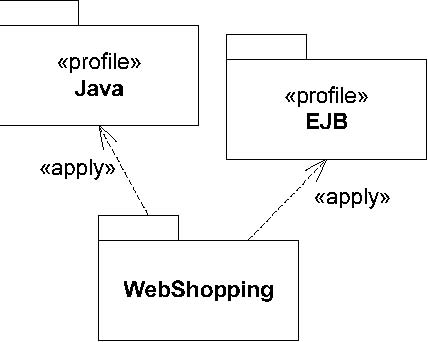*Generalizations
Issue 9183 -replace ‘Constructs::PackageImport ’ by ‘Constructs::Core:DirectedRelationship ’
•
InfrastructureLibrary::Constructs::Core::DirectedRelationship
Description
Issue 9183 -replace ‘PackageImport ’ with ‘DirectedRelationship ’
ProfileApplication is a kind of DirectedRelationship that adds the capability to state that a Profile is applied to a Package.
Attributes
Issue 8706 - add ‘isStrict’ attribute
• isStrict : Boolean [1] = false Specifies whether or not the Profile filtering rules for the metaclasses of the
referenced metamodel shall be strictly applied. See the semantics section of Profile
(from Profiles ) on page 691 for further details.
Associations
Issue 8602 - replace ‘is’ with ‘are’
• importedProfile: Profile [1] References the Profiles that are applied to a Package through this ProfileApplication . Subsets PackageImport ::importedPackage
• applyingPackage : Package [1] The package that owns the profile application. {Subsets Element::owner and DirectedRelationship ::source}
Constraints
No additional constraints
Semantics
One or more profiles may be applied at will to a package that is created from the same metamodel that is extended by the profile.
Applying a profile means that it is allowed, but not necessarily required, to apply the stereotypes that are defined as part
of the profile. It is possible to apply multiple profiles to a package as long as they do not have conflicting constraints.
If a profile that is being applied depends on other profiles, then those profiles must be applied first.
When a profile is applied, instances of the appropriate stereotypes should be created for those elements that are instances
of metaclasses with required extensions. The model is not well formed without these instances.
Once a profile has been applied to a package, it is allowed to remove the applied profile at will. Removing a profile implies
that all elements that are instances of elements defined in a profile are deleted. A profile that has been applied cannot
be removed unless other applied profiles that depend on it are first removed.
Note – The removal of an applied profile leaves the instances of elements from the referenced metamodel intact. It is only
the instances of the elements from the profile that are deleted. This means that for example a profiled UML model can always
be interchanged with another tool that does not support the profile and be interpreted as a pure UML model.
Notation
The names of Profiles are shown using a dashed arrow with an open arrowhead from the package to the applied profile. The keyword
«apply» is shown near the arrow.
If multiple applied profiles have stereotypes with the same name, it may be necessary to qualify the name of the stereotype
(with the profile name).
Examples
Given the profiles Java and EJB,
Figure 18.12 shows how
these have been applied to the package WebShopping.

Figure 18.12 - Profiles applied to a package